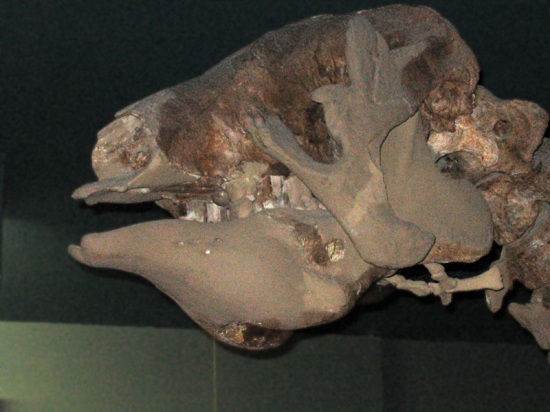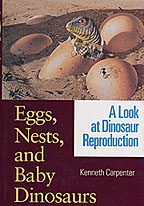There more I learn about the history of life on earth, the more bizarre things get. While extant sloths (Family Bradypodidae for three-toed sloths and Family Megalonychidae for two-toed sloths) have always been familiar to me, it was only recently that I became aware of their competent swimming ability. In fact, someone has even been gracious enough to share some video of a swimming three-toed sloth via YouTube;
What is even more amazing, however, is that there were once an entire group of giant sloths that became increasingly adapted to life in and around the water. When we think of evolution’s various forays into and out of the water, fossil creatures like Tiktaalik roseae and Pakicetus inachus most readily come to mind (and if you’re interested, Carl Zimmer’s At the Water’s Edge is a good place to start), but there are more tales of marine transitions (both ways) than I have time to tell.
Before we can start discussing the details of the five known species of “swimming sloth” lineage, where and when they existed needs to be determined. François Pujos and Rodolfo Salas, in their 2004 paper “A Systematic Reassessment and Paleogeographic Review of Fossil Xenarthra From Peru,” provides a good summation of when various sloths inhabited Peru, with the genus Thalassocnus being of most interest to us;
– Thalassocnus antiquus (late Miocene from Aguada de Lomas)
– Thalassocnus natans (late Miocene from Sud-Sacaco)
– Thalassocnus littoralis (early Pliocene from Sud-Sacaco)
– Thalassocnus carolomartini (early-late Pliocene from Sacaco)
– Thalassocnus yaucensis (late Pliocene from East Yauca [from De Muizon, 2004])

Four species of “marine” sloths as listed above. From top to bottom; Thalassocnus antiquus, Thalassocnus natans, Thalassocnus littoralis, Thalassocnus carolomartini, and Thalassocnus yaucensis (not to scale).
While I wasn’t able to line the skulls up in the correct sizes relative to each other, the differences between the Thalassocnus skulls and other extinct (and extant) sloths is surprising. Compare the skulls above with this head-shot of the extinct Eremotherium;

The snouts of the aquatic sloths (all of which belonging to a group known as the nothrotheres) were much longer than those of other large ground sloths, and appeared to get longer with time. Indeed, the youngest species, Thalassocnus yaucensis appears to have a considerably longer nose than that of the oldest, T. antiquus. These skull extensions stand out even more when compared to the skulls of living sloths, which are known for their snub-nosed appearance.
Given the “long faces” and coastal habitats of these sloths, we’d be foolish to assume that they were arboreal leaf-munchers like living sloths, and the clues to their diets come from their teeth. The wear patterns on mammalian teeth can be quite diagnostic, and upon examining the teeth researchers found that the teeth of the older species were marked by sand abrasions. Anyone who’s had a picnic at the beach can probably recall the unpleasant sensation of sand grinding across their teeth, but when you’re a grazing mammal on the shore you don’t have much choice. Given the sheer amount of sand abrasion on their teeth, the older sloths (T. antiquus, T. natans, and T. littoralis) likely stayed close in-shore, going out into the water but not making great diving forays, and thus sand would likely be in nearly everything they ate. Even if they waded out to munch on sea grass, they would have stirred up a good amount of sand in the water, so either way they would ingest plenty of the sediment.
The teeth of the younger species (T. carolomartini and T. yaucensis) seemed to lack the severe sand-abrasion seen in the older species. In fact, the evidence from their teeth may suggest that they became more specialized and even more aquatic, being able to move out further into the water to crop plants growing near-shore, less of their diet being made up of plants that washed up on the beach or that were accessible from the shallows. This dietary change is also suggested by the overall changes in the skull and lower jaw; the lower jaws of the younger animals are longer with a little “spoon” at the end, while the older ones lack such specializations. Openings for blood vessels in the skull also suggest that the younger sloths had powerful lips, and herbivorous extant sea-mammals (manatees) how powerful lips for grazing as well. This makes sense in that if you need your limbs to swim, anchor yourself into the sand, or cling to rocks; it would be to your advantage to be able to control your food without having to use your hands.
Although the marine habits of this line of sloths seems apparent, we certainly need to ask why they evolved in such a fashion and why they went extinct. While more study is needed on the topic, the sloths seemed to live on a coast backed by desert, deserts providing poor opportunities for browsing or obtaining food. The coast provided much more food in terms of sea grass, kelp, or other plants, and so the sloths were adapted to become more and more efficient at getting their food from the sea. While there are likely fossil sloths still to be discovered and described in the region, the five known species seem to be close to be a single lineage evolving in this one area (the disparity between the two oldest sloths being greater than between later ones). This makes sense in that it’s unlikely that other sloths would cross the desert or swim across the ocean, so if a population (or a few populations) of large sloths became isolated along the coastline, I would expect that they would become more and more adapted to live in their new home.
Overall, the sloths seemed to be doing well in their time, their fossils relatively abundant in the area, but it was not to last; an overall decrease in sea temperature may have reduced their food sources, driving them to extinction (the changing plant availability may have also fueled their specialization). This is just one hypothesis, and extinction is rarely, if ever, a simple and straightforward matter, but these sloths seem to have been eliminated just as they were starting to really get comfortable in their new niche. Who knows what might be shuffling along South American coastlines today if they had not gone extinct?
References:
De Muizon, C., McDonald, H.G., Salas, R., Urbina, M. 2003. A New Early Species of the Aquatic Sloth Thalassocnus (Mammalia, Xenarthra) from the Late Miocene of Peru. Journal of Vertebrate Paleontology 23(4):886–894
De Muizon, C., McDonald, H.G., Salas, R., Urbina, M. 2004. The Evolution of Feeding Adaptation of the Aquatic Sloth Thalassocnus. Journal of Vertebrate Paleontology 24(2):398–410.
De Muizon, C., McDonald, H.G., Salas, R., Urbina, M. 2004. The Youngest Species of the Aquatic Sloth Thalassocnus and a Reassessment of the Relationships of the Nothrothere Sloths (Mammalia: Xenarthra). Journal of Vertebrate Paleontology 24(2):387–397
McDonald, H.G., De Muizon, C. 2002. The Cranial Anatomy of Thalassocnus (Xenarthra, Mammalia), a Derived Nothrothere from the Neogene of the Pisco Formation (Peru). Journal of Vertebrate Paleontology 22(2):349–365
Pujos, F.; Salas, R. 2004. A Systematic Reassessment and Paleogeographic Review of Fossil Xenarthra From Peru. Bull. Inst. fr. études andines 33 (2): 331-377














Great article! I know this highly interesting marine sloths already since some time, but there was always only very little information about them, especially photos or illustrations. So it is great to get not only futher interesting information, but also some cool photos I have never seen before. I think the skull of Thalassocnus yaucensis is especially interesting, it anterior parts of the jaws look nearly a little bit like those of a spoonbill from a dorsal view.
Thank you for the compliments Sordes! I had been meaning to write this post for some time for the very reasons you mentioned; everyone knows the swimming sloths existed, but outside of the technical papers I couldn’t find much other information or pictures of the skulls. It seems that the researchers are pumping out papers fast-and-furious on these new animals, so hopefully there will be plenty more information coming in the future.
Hey there, Laelaps! Any info on the size of these incredible critters?
[…] formation has produced articulated broad-toothed mako shark skeletons as well as fossils of whales, aquatic sloths and sea […]
When in Paris pay a visit to the Musee de l”Histoire Naturelle in the Jardin des Plantes. they have a display on an aquatic sloth with skeleton and artists impression of how it looked. Loads of good stuff there actually … complete skeleton of Eryops (large carboniferous amphibian), numerous mammoths, mastodont skeletons, reconstruction of full sized giant sloth, allosourus and diplodocus skeletons.
[…] fact that ground sloths were actually a highly diverse bunch. Thalassocnus was a genus designed for a heavily sub-aquatic lifestyle, Megalonyx may have sucked the blood of fellow megamammals on occasion, whilst the famed […]
carter is a sloth
[…] formation has produced articulated broad-toothed mako shark skeletons as well as fossils of whales, aquatic sloths and sea […]
[…] formation has produced articulated broad-toothed mako shark skeletons as well as fossils of whales, aquatic sloths and sea […]
[…] more evidence? Pygmy three-toed sloth swimming HD Swimming sloth The Giant Swimming Sloths of South America De Muizon, C., McDonald, H.G., Salas, R., Urbina, M. 2003. A New Early Species of the Aquatic Sloth […]
Marine sloths sound plain WIERD!!
But still, pretty cool. I am working on alternate history novels, maybe one revolving around the continued survival of marine sloths?
[…] At the time, a team of researchers from the Smithsonian and Chile recorded the remains of ten kinds of marine vertebrates from the site, named Cerro Ballena—Spanish for “whale hill.” In addition to the skeletons of more than 40 large baleen whales that dominated the inventory, the team documented the remains of a species of sperm whale and a walrus-like whale, both of which are now extinct. They also found skeletons of billfishes, seals and aquatic sloths. […]
[…] at least two types of seals, an extinct species of sperm whale, a walrus-like toothed whale and an aquatic sloth. The orientation of the bodies indicated that the animals had all died at sea and washed onto a […]
[…] at least two types of seals, an extinct species of sperm whale, a walrus-like toothed whale and an aquatic sloth. The orientation of the bodies indicated that the animals had all died at sea and washed onto a […]
[…] 2007, Brian Switek, the great writer about fossils, suggested the likely reason for the […]
[…] and a walrus-like whale, both now extinct, also died, along with seals, billfishes, bony fish and aquatic sloths . These die-offs, known as mass strandings , appeared to have happened over and over, with the […]
[…] of my favorite examples of problematica is a sea sloth found and added to the fossil records. We have a modern version of the creature – slow […]
[…] In fact, fossil evidence suggests there was once a species of giant aquatic sloths that were adapted for life in the […]
[…] In fact, fossil evidence suggests there was once a species of giant aquatic sloths that were adapted for life in the […]
[…] In fact, fossil evidence suggests there was once a species of giant aquatic sloths that were adapted for life in the […]
[…] In fact, fossil evidence suggests there was once a species of giant aquatic sloths that were adapted for life in the […]
[…] In fact, fossil evidence suggests there was once a species of giant aquatic sloths that were adapted for life in the […]